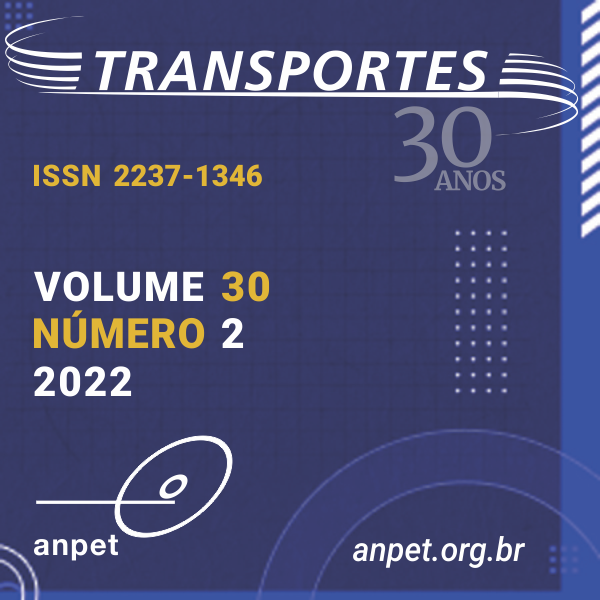Investigation of titanium nanoparticles-reinforced Asphalt Composites Using Rheological Tests
DOI:
https://doi.org/10.14295/transportes.v30i2.2614Keywords:
Nanomaterial, Modified binder, Binder rheological evaluation, OleylamineAbstract
Asphalt binder modification techniques are beneficial for the performance improvement of roads because they can be durable, present less permanent deformation, and provide longer fatigue life. The main modification agents involved in this process are polymers, fillers, fibers, and, more recently, nanomaterials, which have presented technical and economic feasibility. The nanoparticles were added to the base asphalt binder at a concentration of 3% of weight in pure and surface-modified states. This study aims to analyze the effect of surface modification of titanium dioxide nanoparticles using three different agents: oleic acid, benzyl alcohol, and oleylamine. The results have indicated that surface modification of the nanoparticles with oleylamine improved the interaction between the particles and the binder, contributing to increasing fatigue life and resistance to permanent deformation and delaying the aging process. Furthermore, the results of rheological tests have indicated that incorporating nanoparticles surface-modified with oleylamine into modified asphalt binder 55/75-E and asphalt binder 50/70 has produced higher resistance to the aging process less susceptibility to permanent deformation and cracks.
Downloads
References
AASHTO (2010) M 320-10: Standard Specification for: Performance-Graded Asphalt Binder. Washington, D.C.: American Association of State Highway and Transportation Officials.
AASHTO (2012) TP 101: Standard Method of Test for Estimating Fatigue Resistance of Asphalt Binders Using the Linear Amplitude Sweep. Washington, D.C.: American Association of State Highway and Transportation Officials.
AASHTO (2021) M 332: Standard Specification for Performance-Graded Asphalt Binder Using Multiple Stress Creep Recovery (MSCR) Test. Washington, D.C.: American Association of State Highway and Transportation Officials.
Alcântara, G. B. (2007) Nanopartículas de maguemita complexadas com ácido oleico. Dissertation (Master in Physics). IF - Programa de Pós-Graduação, Universidade de Brasília. Brasília. Available at: https://repositorio.unb.br/handle/10482/1459 (Accessed: 01 Jul 2022).
ASTM (2006) D36: Standard Test Method for Softening Point of Bitumen (Ring-and-Ball Apparatus). West Conshohocken: American Society for Testing and Materials.
ASTM (2013) D5: Standard Test Method for Penetration of Bituminous Materials. West Conshohocken: American Society for Testing and Materials.
ASTM (2015a) D4402: Standard Test Method for Viscosity Determination of Asphalt at Elevated Temperatures Using a Rotational Viscometer. West Conshohocken: American Society for Testing and Materials.
ASTM (2015b) D7405-15: Standard Test Method for Multiple Stress Creep and Recovery (MSCR) of Asphalt Binder Using a Dynamic Shear Rheometer. West Conshohocken: American Society for Testing and Materials.
ASTM (2016) D6373: Standard Specification for Performance-Graded Asphalt Binder. West Conshohocken: American Society for Testing and Materials.
ASTM (2018) D6084: Standard Test Method for Elastic Recovery of Asphalt Materials by Ductilometer. West Conshohocken: American Society for Testing and Materials.
Beck Júnior, W. (2011) Nanopartículas magnéticas metálicas recobertas com óxido de ferro: intensificação das propriedades magnéticas da nanopartícula e funcionalização para aplicação em biomedicina. Dissertation (Master in Science). Instituto de Química de São Carlos, Universidade de São Paulo. São Carlos. DOI: 10.11606/d.75.2011.tde-02052011-144102.
Faruk, A. N. M. et al. (2014) “Application of Nano-Technology in Pavement Engineering: A Literature Review” in Application of Nanotechnology in Pavements, Geological Disasters, and Foundation Settlement Control Technology. American Society of Civil Engineers, pp. 9–16. DOI: 10.1061/9780784478448.002.
Golestani, B. et al. (2015) “Nanoclay application to asphalt concrete: Characterization of polymer and linear nanocomposite-modified asphalt binder and mixture” Construction and Building Materials, 91, pp. 32–38. DOI: 10.1016/j.conbuildmat.2015.05.019.
Hassan, M. M. et al. (2012) “Laboratory Evaluation of Environmental Performance of Photocatalytic Titanium Dioxide Warm-Mix Asphalt Pavements” Journal of Materials in Civil Engineering, 24(5), pp. 599–605. DOI: 10.1061/(asce)mt.1943-5533.0000408.
Hintz, C. and Bahia, H. (2013) “Simplification of Linear Amplitude Sweep Test and Specification Parameter” Transportation Research Record, 2370(1), pp. 99–106. DOI: 10.3141/2370-02.
Hong, R. Y. et al. (2009) “Synthesis, surface modification and photocatalytic property of ZnO nanoparticles” Powder Technology, 189(3), pp. 426–432. DOI: 10.1016/j.powtec.2008.07.004.
Johnson, C. M. and Bahia, H. U. (2010) “Evaluation of an Accelerated Procedure for Fatigue Characterization of Asphalt Binders” Road Materials and Pavement Design. Available at: https://uwmarc.wisc.edu/files/linearamplitudesweep/RMPD10_LAS_CMJ_HB-100321.pdf (Accessed: 01 Jul 2022).
Li, G.-Y. et al. (2008) “Preparation and properties of magnetic Fe3O4–chitosan nanoparticles” Journal of Alloys and Compounds, 466(1–2), pp. 451–456. DOI: 10.1016/j.jallcom.2007.11.100.
Li, R. et al. (2017) “Developments of nano materials and technologies on asphalt materials – A review” Construction and Building Materials, 143, pp. 633–648. DOI: 10.1016/j.conbuildmat.2017.03.158.
Magalhães, M. J. M. (2014) Síntese e modificação da superfície de nanocristais semicondutores para aplicação como sondas fluorescentes em meio não-aquoso. Dissertation (Master in Quality Control). Faculdade de Farmácia, Universidade do Porto. Porto. Available at: https://repositorio-aberto.up.pt/bitstream/10216/77261/2/33381.pdf (Accessed: 01 Jul 2022).
Mahali, I. and Sahoo, U. C. (2019) “Rheological characterization of Nanocomposite modified asphalt binder” International Journal of Pavement Research and Technology, 12(6), pp. 589–594. DOI: 10.1007/s42947-019-0070-8.
Marinho Filho, P. G. T. (2017) Avaliação reológica de ligantes asfálticos modificados com nanopartículas de dióxido de titânio. Dissertation (Master in Civil and Environmental Engineering). Programa de Pós-Graduação em Engenharia Civil e Ambiental, Universidade Federal de Campina Grande. Campina Grande. Available at: http://dspace.sti.ufcg.edu.br:8080/jspui/handle/riufcg/374 (Accessed: 01 Jul 2022).
Medeiros, I. A. F. de (2018) Nanoestruturação de Ferritas de Cobalto (CoxFe3-xO4): efeito sobre a catálise e sobre a detecção de gases poluentes. Thesis (PhD in Chemical Engineering). Programa de Pós-Graduação em Engenharia Química, Universidade Federal do Rio Grande do Norte. Natal. Available at: https://repositorio.ufrn.br/jspui/handle/123456789/26212 (Accessed: 01 Jul 2022).
Mourdikoudis, S. and Liz-Marzán, L. M. (2013) “Oleylamine in Nanoparticle Synthesis” Chemistry of Materials. American Chemical Society, 25(9), pp. 1465–1476. DOI: 10.1021/cm4000476.
NCHRP (2001) Report 459 - Characterization of Modified Asphalt Binders in Superpave Mix Design. Washington, D.C.: National Cooperative Highway Research Program.
Olsen, R. E. (2013) Synthesis, characterization, and application of high surface area, mesoporous, stabilized anatase TiO2 catalyst supports. Dissertation (Doctor of Philosophy). Department of Chemistry and Biochemistry, Brigham Young University. Provo. Available at: http://hdl.lib.byu.edu/1877/etd6632 (Accessed: 01 Jul 2022).
Possebon, É. P. (2021) Caracterização avançada de ligantes e misturas asfálticas brasileiras. Thesis (PhD in Civil Engineering). Programa de Pós-Graduação em Engenharia Civil, Universidade Federal de Santa Maria. Santa Maria. Available at: http://repositorio.ufsm.br/handle/1/22487 (Accessed: 01 Jul 2022).
Rong, M. Z., Zhang, M. Q. and Ruan, W. H. (2006) “Surface modification of nanoscale fillers for improving properties of polymer nanocomposites: a review” Materials Science and Technology, 22(7), pp. 787–796. DOI: 10.1179/174328406x101247.
Shafabakhsh, G., Mirabdolazimi, S. M. and Sadeghnejad, M. (2014) “Evaluation the effect of nano-TiO2 on the rutting and fatigue behavior of asphalt mixtures” Construction and Building Materials, 54, pp. 566–571. DOI: 10.1016/j.conbuildmat.2013.12.064.
Sobreiro, F. P. (2015) Efeito da adição de ácidos fosfóricos no comportamento reológico de ligantes asfálticos puros e modificados com copolímero SBS. Thesis (PhD in Science). Escola de Engenharia de São Carlos, Universidade de São Paulo. São Carlos. DOI: 10.11606/t.18.2014.tde-28052014-100359.
Sousa Neto, V. F. de (2019) Avaliação reológica do ligante asfáltico modificado com nanopartículas de óxido de zinco. Dissertation (Master in Civil and Environmental Engineering). Programa de Pós-Graduação em Engenharia Civil e Ambiental, Universidade Federal de Campina Grande. Campina Grande. Available at: http://dspace.sti.ufcg.edu.br:8080/jspui/handle/riufcg/3342 (Accessed: 01 Jul 2022).
Tanzadeh, J. et al. (2012) “Laboratory Study on the Effect of Nano TiO2 on Rutting Performance of Asphalt Pavements” Advanced Materials Research, 622–623, pp. 990–994. DOI: 10.4028/www.scientific.net/amr.622-623.990.
Viali, W. R. (2009) Síntese e Caracterização de nanopartículas de maghemita revestidas com ácido oléico para obtenção de fluidos magnéticos a base de óleos isolantes. Dissertation (Master in chemistry). Instituto de Química, Universidade Federal de Goiás. Goiânia. Available at: http://repositorio.bc.ufg.br/tede/handle/tde/1059 (Accessed: 01 Jul 2022).
Wang, L. S. and Hong, R. Y. (2011) “Synthesis, Surface Modification and Characterisation of Nanoparticles”, in B. Reddy (ed.), Advances in Nanocomposites - Synthesis, Characterization and Industrial Applications, IntechOpen, London. DOI: 10.5772/10540.
Yang, S. et al. (2018) “Ultraviolet and PAV aging procedures influence on rheological characteristics of Sasobit/SBS modified binder containing titanium dioxide nanoparticles” Petroleum Science and Technology, 36(19), pp. 1524–1530. DOI: 10.1080/10916466.2018.1476535.
You, L. et al. (2018) “Assessment of nanoparticles dispersion in asphalt during bubble escaping and bursting: Nano hydrated lime modified foamed asphalt” Construction and Building Materials, 184, pp. 391–399. DOI: 10.1016/j.conbuildmat.2018.06.234.
You, Z. et al. (2011) “Nanoclay-modified asphalt materials: Preparation and characterization” Construction and Building Materials, 25(2), pp. 1072–1078. DOI: 10.1016/j.conbuildmat.2010.06.070.
Zhang, H. et al. (2015) “Influence of surface modification on physical and ultraviolet aging resistance of bitumen containing inorganic nanoparticles” Construction and Building Materials, 98, pp. 735–740. DOI: 10.1016/j.conbuildmat.2015.08.138.
Downloads
Published
How to Cite
Issue
Section
License
Copyright (c) 2022 Paulo Germano Tavares Marinho Filho, Lêda Christiane de Figueirêdo Lopes Lucena, Matheus Costa Lopes

This work is licensed under a Creative Commons Attribution 4.0 International License.
Authors who submit papers for publication by TRANSPORTES agree to the following terms:
- The authors retain the copyright and grant Transportes the right of first publication of the manuscript, without any financial charge, and waive any other remuneration for its publication by ANPET.
- Upon publication by Transportes, the manuscript is automatically licensed under the Creative Commons License CC BY 4.0 license. This license permits the work to be shared with proper attribution to the authors and its original publication in this journal.
- Authors are authorized to enter into additional separate contracts for the non-exclusive distribution of the version of the manuscript published in this journal (e.g., publishing in an institutional repository or as a book chapter), with recognition of the initial publication in this journal, provided that such a contract does not imply an endorsement of the content of the manuscript or the new medium by ANPET.
- Authors are permitted and encouraged to publish and distribute their work online (e.g., in institutional repositories or on their personal websites) after the editorial process is complete. As Transportes provides open access to all published issues, authors are encouraged to use links to the DOI of their article in these cases.
- Authors guarantee that they have obtained the necessary authorization from their employers for the transfer of rights under this agreement, if these employers hold any copyright over the manuscript. Additionally, authors assume all responsibility for any copyright infringements by these employers, releasing ANPET and Transportes from any responsibility in this regard.
- Authors assume full responsibility for the content of the manuscript, including the necessary and appropriate authorizations for the disclosure of collected data and obtained results, releasing ANPET and Transportes from any responsibility in this regard.









